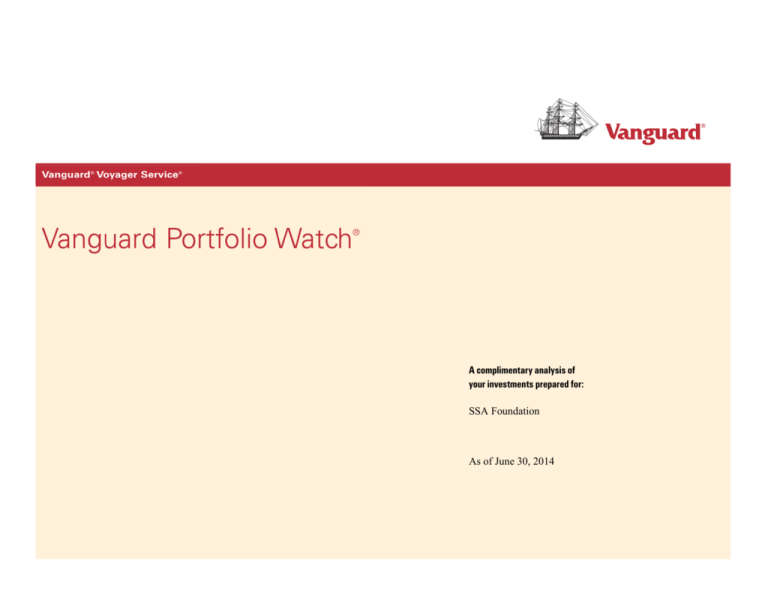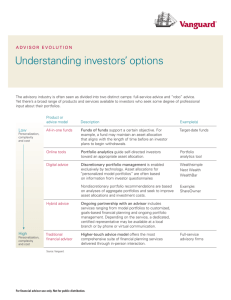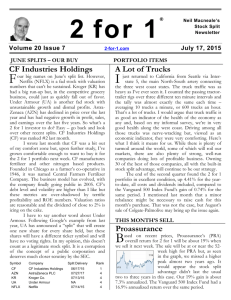
A complimentary analysis of
your investments prepared for:
SSA Foundation
As of June 30, 2014
What You'll See About Risk
Because diversification is a powerful risk-reduction tool, most sections
of this report focus on the degree to which your stock and bond
holdings are diversified.1
We compare your stock investments with overall market benchmarks,
as they are the very definition of stock-market diversification. The more
your holdings vary from overall market weightings in terms of
capitalization, style, and industry sector, the greater the probability that
your returns will differ, higher or lower, from the market. For your bond
portfolio, we gauge diversification by analyzing the overall credit quality
and interest rate sensitivity of your bond holdings.
How to Use This Analysis
Vanguard is pleased to provide you with Portfolio Watch, an analysis of your portfolio based on our
time−tested investment principles. Our goal in providing it to you is to help you better monitor and
manage your portfolio by focusing on investment factors you can control. We’ve designed our analysis to
be informative to sophisticated and novice investors alike.
Much of this report deals with risk because although it is inevitable in investing, risk is a factor you can
Of course, you or your investment manager may have chosen to deviate control to a large extent. And, once you understand the types of risks your portfolio is most vulnerable to,
you can decide whether they’re at a level you are comfortable with. We also focus on some of the
from stock-market benchmark weights to try for higher returns and
investment and tax costs that inevitably shrink returns, because cost is another factor you can control.
accept the higher risks, or to concentrate on certain bonds to meet
specific investment goals.
We examined your investments−all your Vanguard® assets, assets you hold in a Vanguard® Brokerage
The results of each analysis will be accompanied by one of these icons: account, and any non−Vanguard assets you track on vanguard.com from multiple points of view:
Your portfolio is characterized by broad diversification, low costs,
Your overall exposure to market risk (Section 2).
or tax efficiency.
Some aspect of your portfolio appears to add a moderate
amount of risk, cost, or extra taxes.
Some aspect of your portfolio appears to add a substantial
amount of risk, cost, or extra taxes.
This information can help you better manage your portfolio.
Note: All footnotes appear at the end of the report.
Your exposure to specific risks in the stock and bond markets (Sections 3, 4, and 5).
Your mutual fund costs and the tax efficiency of your portfolio (Sections 6 and 7).
The report concludes with steps you can take to update and further customize your analysis or to get help
in fine−tuning your investment strategy (Section 8).
A member of your Voyager Service® team will be happy to discuss any aspect of this report with you,
including Vanguard’s planning and advice services, which can provide you with specific
recommendations based on your personal situation and investment goals.
You can reach your Voyager team at 1-800-284-7245.
For more information about Vanguard funds, visit www.vanguard.com, or call 1-800-284-7245, to obtain a prospectus.
Investment objectives, risks, charges, expenses, and other important information about a fund are contained in the
prospectus; read and consider it carefully before investing.
1. Assets Analyzed
Vanguard accounts
$3,286,248.87
Outside investments
$0.00
Total assets
2. Your Asset Allocation
Your Current Asset Allocation
$3,286,248.87
Vanguard's Investment Principles
How a portfolio is allocated among asset classes is
the most significant determinant of long−term
returns.
The most important decision investors make is the
mix of assets they select, not the individual
investments they purchase. Asset mix should be
based on an investor’s financial objectives, risk
tolerance, and time horizon (which is often
influenced by an investor’s age).
Stock
62.6%
Bond
37.4%
Short-term reserves
0.0%
Other
0.0%
Total
Your report takes into consideration all the accounts
you hold at Vanguard and the outside investments you
track on our website. All the accounts are listed in
Section 9.
In choosing an asset mix, investors should balance
their need for asset growth against their willingness
to accept the negative returns that a given mix
could produce in some years.
Understanding the volatility of past returns
associated with a given asset mix will help
investors assess their risk tolerance. Investors
shouldn’t expect future long−term returns to differ
significantly from the markets’ long−term historical
averages.
This chart and table categorize your holdings based
on 3 broad asset classes−stocks, bonds, and short−
term reserves. 2
To get the most out of your analysis, include your non-Vanguard
assets. You can enter them as outside investments on vanguard.com.
100.0%
Page 1 of 13
Vanguard Portfolio Watch
Prepared for SSA Foundation
For the Period Ending June 30, 2014
Page 2 of 13
2. Your Asset Allocation (cont.)
Historical Returns and Volatility of
an Asset Allocation Similar to
Yours 3
Average annual total return, 1926-2013
Volatility of returns:
8.9%
Best single year
37.8% (1933)
Worst single year
-27.7% (1931)
Number and percentage of
years with a loss
22 of 88
(25.0%)
This table does not reflect actual historical
performance for your portfolio. It is designed to help
you gauge your tolerance for market fluctuations by
showing what the performance would have been for a
portfolio that both had your current asset mix
throughout the period shown and was
well−diversified.
These returns are based on broad market indexes; the returns of
your holdings might have been more volatile.
3. Your Stock Portfolio
Vanguard's Investment Principles
Broad diversification across all segments of the
domestic stock market reduces volatility.
Large−, mid−, and small−capitalization stocks
should be held in proportions similar to those of the
overall U.S. stock market.
Investors should hold both growth stocks and value
stocks in similar proportions.
International investing aids diversification. Because
of the additional risks inherent in international
investing, we believe that no more than 40% of a
stock portfolio should be invested abroad.
An Important Stock Investing Consideration
Some individual investors and fund managers aim for
higher−than−market returns by emphasizing stocks of
certain market capitalizations, investing styles, or
industry sectors. These investors take on the risk that
their return will be less than that of the market if
assets they’re overweighted in perform poorly or
those that they’re underweighted in perform well.
Consistently outperforming the market by deviating
from market weightings is extremely difficult.
Individual Stocks and Stock Funds
62.7% of Your Analyzed Assets
Domestic and International
U.S. stocks
69.3%
International stocks
30.7%
Uncategorized stocks
0.0%
Total
Domestic Stocks and Stock Funds
43.5% of Your Analyzed Assets
Market Capitalization
100.0%
Your stock
portfolio
U.S. stock Difference
market 4 (percentage pts)
Large cap
64.0%
64.0%
0.0
Mid cap
28.0%
28.0%
0.0
Small cap
8.0%
8.0%
0.0
100.0%
100.0%
Total
Investment Style
Over/Under weighting
(percentage points)
Your stock
portfolio
Value
You
Market
your portfolio.
Value
0.0%
Blend
100.0%
Growth
Total
0.0%
This table shows the size of the companies in your
stock portfolio as measured by their capitalization, or
the total market value of their shares.
Your domestic stock holdings are well diversified among large-, mid-,
and small-capitalization companies.
The predominant investment style−"growth," "value,"
or a "blend" of both−of your stock holdings is shown
in the bar chart. The overall style is based on the
proportionate mix of each style in your stock
portfolio, shown in the table.5
Your portfolio has a good balance of value stocks and growth stocks.
100.0%
Growth
Page 3 of 13
Vanguard Portfolio Watch
Prepared for SSA Foundation
For the Period Ending June 30, 2014
Page 4 of 13
3. Your Stock Portfolio (cont.)
Industry Sectors
Sector
U.S. stock Difference
market 6 (percentage pts)
Basic materials
3.0%
3.0%
0.0
Communication services
4.0%
4.0%
0.0
Consumer cyclical
11.0%
11.0%
0.0
Consumer defensive
9.0%
9.0%
0.0
Energy
10.0%
10.0%
0.0
Financial services
14.0%
14.0%
0.0
Health care
13.0%
13.0%
0.0
Industrials
12.0%
12.0%
0.0
Real estate
4.0%
4.0%
0.0
Technology
17.0%
17.0%
0.0
Utilities
3.0%
3.0%
0.0
100.0%
100.0%
Total
International Stocks and Stock
Funds
19.2% of Your Analyzed Assets
Your stock
portfolio
Your stock Stock markets outside the Difference
portfolio U.S. 7
(percentage pts)
Developed Markets
Europe
46.4%
49.0%
-2.6
Pacific
27.6%
23.0%
4.6
Canada
7.5%
7.0%
0.5
Emerging Markets
18.1%
21.0%
-2.9
Uncategorized Holdings
0.4%
0.0%
0.4
100.0%
100.0%
Total
This table breaks down your stock holdings by
industry sector and compares the weighting of each
with those of the market.
This table shows how your foreign stock holdings are
allocated to various regions based on market value. It
also compares your allocation with the weightings of
an international stock benchmark.
Your proportions of stocks from developed and emerging markets are
similar to the market's, which means your overall international stock
returns should closely match those of the market.
4. Your Bond Portfolio
Vanguard's Investment Principles
While stocks are the driving force behind long−term
portfolio growth, bonds−which typically fluctuate
far less than stocks−should be included in most
portfolios to temper stocks’ short−term volatility.
Broad diversification of bond holdings−in terms of
credit quality and interest rate sensitivity−helps to
reduce risk. Investors may also choose not to
diversify (within limits) if they’re aware of the
tradeoffs. For example, an investor may
concentrate on Treasury bonds to eliminate credit
risk (at the cost of lower returns over the long term
compared with investing in corporate bonds). Or, an
investor may emphasize short−term bonds to
minimize interest rate sensitivity (and give up the
higher income that longer−term bonds provide).
Individual Bonds and Bond Funds
37.3% of Your Analyzed Assets
Domestic and International
Domestic bonds
International bonds
0.0%
Uncategorized bonds
0.0%
Total
Individual Bonds and Bond Funds
37.3% of Your Analyzed Assets
Taxable and Municipal
100.0%
Taxable bonds
100.0%
100.0%
Municipal bonds
0.0%
Uncategorized bonds
0.0%
Total
100.0%
Important Bond Relationships
Credit quality refers to the likelihood that a bond’s
principal will be repaid by the issuer. The higher a
bond’s credit quality, the lower the risk of
nonpayment or default−and, generally, the lower
the yield.
Bond prices change in the opposite direction of
interest rate changes. We refer to the magnitude of
the price change as interest rate sensitivity. The
longer a bond’s maturity, the greater its price will
fluctuate in response to changes in interest rates.
Bonds are categorized as either domestic or
international.
Adding some currency-hedged, foreign bonds could
potentially increase your portfolio diversification. An allocation of about
20% of your bonds in a low-cost, currency-hedged, international bond fund
is a reasonable approach to capture the diversification benefits.
Bonds are categorized as either taxable (interest is
subject to income tax) or municipal (interest is
generally free from income tax).
This section focuses on the credit quality and interest
rate sensitivity of your bonds. The tax aspects of your
bonds are addressed in Section 7.
Page 5 of 13
Vanguard Portfolio Watch
Prepared for SSA Foundation
For the Period Ending June 30, 2014
Page 6 of 13
4. Your Bond Portfolio (cont.)
Credit Quality 8
37.3% of Your Analyzed Assets
Your taxable Your municipal
bonds
bonds
Your total bonds
High
38.5%
0.0%
38.5%
Medium
60.9%
0.0%
60.9%
Low
0.6%
0.0%
0.6%
Total
100.0%
0.0%
100.0%
This table shows what portion of your bond holdings
are invested in bonds with high, medium, and low
credit quality. Excludes international bond holdings.
Your investments in low-credit-quality bonds, which have a greater
risk of default than higher-credit-quality bonds, provide some diversification
and higher yields.
However, the overall fund is categorized as a high-credit-quality,
medium-interest-rate-sensitive investment.
Interest Rate Sensitivity 9
37.3% of Your Analyzed Assets
Your taxable Your municipal
bonds
bonds
Your total bonds
High (Long-term)
7.5%
0.0%
7.5%
Medium (Intermediate-term)
51.9%
0.0%
51.9%
Low (Short-term)
40.6%
0.0%
40.6%
100.0%
0.0%
100.0%
Total
This table shows what portion of your bond holdings
are invested in bonds with high, medium, and low
interest rate sensitivity. Excludes international bond
holdings.
Your bond holdings are not weighted strongly toward short- or longterm bonds.
5. Manager Risk
Vanguard's Investment Principles
It is difficult for anyone to predict−consistently and
accurately−which individual securities or actively
managed funds will outperform the market.
Diversified portfolios minimize risk because subpar
performance in one area often can be tempered by
good performance in another.
Index funds, which track the returns of a market
benchmark and don’t try to predict which
individual securities will perform well, are an
efficient and low−cost way to diversify across a
market or market segment.
Although most actively managed funds don’t
outperform the market over the long term, some
actively managed funds do offer the potential for
above−market returns. For investors who choose
actively managed funds, select funds that operate at
the lowest possible cost.
Combining active and indexing strategies offers the
best of both worlds: the low costs and relative
performance predictability of index funds and the
potential for outperformance offered by actively
managed funds, albeit at a higher cost than index
funds.
Holding individual securities dilutes portfolio
diversification and can significantly amplify
portfolio volatility.
Types of Stock and Bond
Investments
Index funds
81.5%
Actively managed funds
18.5%
Individual stocks
0.0%
Individual bonds
0.0%
Other assets
0.0%
Total
Index funds are the core of your portfolio, providing the benefit of
significant diversification at low cost. Including one or more carefully
chosen, low-cost, actively managed funds can add the potential for abovemarket returns.
100.0%
Page 7 of 13
Vanguard Portfolio Watch
Prepared for SSA Foundation
For the Period Ending June 30, 2014
6. Investment Costs
Mutual Fund Expense Ratios10
Page 8 of 13
Vanguard's Investment Principles
Costs matter a great deal. Investment returns are
reduced dollar for dollar by fees, commissions,
transaction expenses, and any taxes incurred.
(Taxes are addressed in Section 7.)
Vanguard
fund average
Mutual fund
industry
average
A mutual fund’s operating costs are expressed as its
expense ratio, which is the percentage of assets used
to pay such costs over the course of a year.11
Your portfolio's
average
Mutual fund expenses
Your savings
1.08%
1.00%
Low−cost funds have a head start compared with
high−cost funds that have similar objectives,
because expenses act as a drag on returns.
The average annual expense ratio for the mutual funds in your
portfolio is substantially lower than the average annual expense ratio of
the industry. Your savings, compared with the costs of the industry
average mutual fund, would have been approximately $32,791 during the
past year.
Not shown are other investment costs: Some
companies charge loads, commissions, and other fees
that reduce your net investment returns.
0.19%
0.08%
Note: Expense ratio data provided by Vanguard and
Lipper Inc. as of December 31, 2013.
7. Tax Efficiency of Your
Portfolio
Vanguard's Investment Principles
Investors should maximize the tax efficiency of their
portfolio because taxes have the potential for taking
the biggest bite out of investment returns over the
long run.
Although tax−efficient investing is important,
investors must also be sure to preserve the right
asset mix. When necessary, adjustments should
generally be made in tax−advantaged accounts
whenever possible.
To save on taxes, investors should use tax−
advantaged retirement accounts to the extent
possible. Those in a high tax bracket should also
consider municipal bond funds and tax−managed
funds.
Tax Efficiency
Percentage of your
portfolio
Tax-advantaged accounts (such as IRAs, 401(k)
accounts, and Education Savings Accounts)
0.0%
Other tax-efficient assets
Index and tax-managed stock and balanced funds
62.7%
Tax-free bonds, bond funds, and money market funds12
0.0%
Individual stocks
0.0%
This table highlights holdings that are tax−efficient−
those that minimize the tax bite−and those that may
not be.
Investors in high tax brackets can reduce taxes by investing
in municipal bonds or bond funds or municipal money market funds. A
simple calculation can show whether you should hold taxable or municipal
securities in your portfolio. Ask a member of your Voyager Service® team
to assist you with the comparison.
Possible tax reduction opportunities
Other stock and balanced funds
0.0%
Taxable bonds and bond funds
37.3%
Taxable money market funds and other cash investments
0.0%
Other investments
0.0%
Total
100.0%
Page 9 of 13
Vanguard Portfolio Watch
Prepared for SSA Foundation
For the Period Ending June 30, 2014
8. Next Steps
Page 10 of 13
We hope you found this Portfolio Watch report
valuable.
Here are some steps you can take to make this
analysis even more helpful:
If you haven’t done so already, broaden this analysis
by consolidating your non−Vanguard assets in a
Vanguard® Brokerage account or by entering your
non−Vanguard assets as "outside investments" on our
website.
Preview how changes you’re considering will affect
your portfolio before you implement them through
our online Portfolio Tester(TM) tool. Note: Before
you make any changes to your portfolio, take any
potential tax consequences into consideration.
Use our advice services. A Vanguard financial
planner can prepare a customized plan for you. Or our
experienced investment managers can manage your
assets for you on an ongoing basis.
vanguard.com.
Customize this analysis by choosing onvanguard.
com only the accounts you would like to use in your
analysis.
Thank you for entrusting your assets to Vanguard!
Use Vanguard’s Investor Questionnaire to create or
confirm your long−term target asset allocation. The
questionnaire is available on our website. Or ask us
for a copy.
9. Accounts Included in This
Analysis
We used the following accounts in analyzing your
portfolio. Note that some mutual funds may appear in
this listing more than once: This is because we have
separated each fund’s holdings by asset class.
To be most meaningful, any analysis of your portfolio
should include all your assets. You can make an
analysis more comprehensive by consolidating non−
Vanguard assets in a Vanguard Brokerage account or
by entering them as "outside investments" at
vanguard.com. The value of your outside holdings
will be calculated as of the previous market close,
rather than month−end.
Note: In the account listing, the abbreviation NA
means that data is not available or not applicable.
Holdings Categorized by Asset Allocation
Domestic Large Cap Stocks
Balance
Percent of portfolio
Expense ratio
Active/Index
Style
Sector
Index
Diversified
Multisector
Active/Index
Style
Sector
Index
Diversified
Multisector
Active/Index
Region
Index
Multiregion
The Soaring Society Of America Foundation
Account
Vanguard Total Stock Mkt Idx Adm (64%)
Domestic Mid/Small Cap Stocks
$914,216.97
Balance
27.8%
Percent of portfolio
0.1%
Expense ratio
The Soaring Society Of America Foundation
Account
Vanguard Total Stock Mkt Idx Adm (36%)
International Stocks
$514,247.05
Balance
15.6%
Percent of portfolio
0.1%
Expense ratio
The Soaring Society Of America Foundation
Account
Vanguard Tot Intl Stock Ix Admiral
Bonds
$630,516.00
Balance
19.2%
Percent of portfolio
0.1%
Expense ratio
Active/Index
Domestic/
International
Taxable/
Municipal
Credit quality
Interest rate
sensitivity
The Soaring Society Of America Foundation
Account
Vanguard Inter-Term Invest-Gr Adm
$386,062.10
11.7%
0.1%
Active
Domestic
Taxable
Medium
Medium
$223,481.41
6.8%
0.1%
Active
Domestic
Taxable
Medium
Low
$617,725.34
18.8%
0.1%
Index
Domestic
Taxable
Various
Various
The Soaring Society Of America Foundation
Account
Vanguard Short-Term Invest-Gr Adm
The Soaring Society Of America Foundation
Account
Vanguard Total Bond Mkt Index Adm
Page 11 of 13
Vanguard Portfolio Watch
Prepared for SSA Foundation
For the Period Ending June 30, 2014
Portfolio Total
Page 12 of 13
$3,286,248.87
100.0%
Footnotes
(Visit Vanguard.com for more details.)
1. (a) We have used the latest available data for both Vanguard and non-Vanguard
investments at the time this report was generated. (b) Assets of Vanguard® funds
and non-Vanguard funds are generally categorized based on their long-term
investment strategies and not the actual holding proportions at the time this report
was produced. Some non-Vanguard fund holdings in subasset classes outside the
fund's long-term strategy may be allocated to appropriate asset classes reflecting
this strategy. (c) Morningstar, Inc., provides the data for non-Vanguard funds and
individual stocks, unless otherwise noted. Vanguard's and Morningstar's methods
of categorizing funds may differ. (d) In some cases, your assets are labeled
"uncategorized." This occurs when our external sources of data are unclear as to
the type of asset you're holding. (e) In a diversified portfolio, gains from some
investments may help offset losses from others. However, diversification does not
ensure a profit or protect against a loss.
2. (a) Short-term reserves include assets such as money market funds, Treasury
bills, and bank CDs. Bonds include short-term, intermediate-term, and long-term
bonds as well as fixed annuities and stable value funds. (b) A category called
"other assets" may also be shown if you track assets such as precious metals, unit
investment trusts, and limited partnerships. "Other assets" also includes any
uncategorized assets.
3. (a) Period covered is from January 1, 1960, through the most current year-end
available. (b) For stock market returns, we use the Wilshire 5000 Total Market
Index for years after 1970 and the Standard & Poor's 500 Index from 1960 to 1970.
For bond market returns, we use the Lehman Brothers U.S. Government/Credit
Bond Index for years after 1972, the Citigroup High Grade Index from 1969 to 1972,
and the Standard & Poor's High Grade Corporate Index from 1960 to 1968. For the
returns on short-term reserves, we use the Citigroup 3-Month Treasury Bill Index.
(c) If your portfolio includes other assets, it's assumed that they are spread pro rata
among stocks, bonds, and short-term reserves. (d) Treasury bills are guaranteed as
to the timely payment of principal and interest; U.S. corporate bonds and stocks
carry no such guarantee. (e) The returns shown include the reinvestment of
dividend income and capital gains distributions; they do not reflect the effects of
investment expenses and taxes. (f) Past performance is not a guarantee of future
results.
4. The U.S. stock market is represented by the MSCI® US Broad Market Index. The
market-value categories for Vanguard funds are based on the Russell 3000 index;
for non-Vanguard funds, on definitions provided by Morningstar.
5. The "value" style involves investing in stocks that are considered low-priced
compared to the issuing company's potential earnings, sales growth, or assets.
The "growth" style involves investing in stocks of companies that have fastgrowing sales and earnings. Style classifications for non-Vanguard funds are
provided by Morningstar.
6. The U.S. stock market is represented by Vanguard® Total Stock Market Index
Fund as a proxy for the MSCI® US Broad Market Index. Industry sectors are
based on Morningstar categories.
7. (a) The stock markets of developed countries outside the United States are
represented by the MSCI All Country World Index Free ex-USA. Non-Vanguard funds
may include emerging market countries in their developed-market categories. (b)
Some U.S. stocks may be categorized as Canadian stocks. (c) Investments in
stocks issued by non-U.S. companies are subject to risks including
country/regional risk and currency risk.
8. Bond credit quality is based on ratings issued by Moody's Investors Service.
9. Interest rate sensitivity of bond mutual funds is described as duration, which is
a measure of the volatility of a bond or bond fund in response to a change in
interest rates. The greater the duration (given in years), the greater the volatility.
For individual bonds, we base interest rate sensitivity on their maturities because
comprehensive duration data is not available. As with duration, the longer a bond's
maturity, the greater its volatility. Bond funds are subject to the risk that an issuer
will fail to make payments on time, and that bond prices will decline because of
rising interest rates or negative perceptions of an issuer's ability to make
payments.
10. (a) Your portfolio expense ratio is a weighted average of the expense ratios of
all the funds you own, excluding any annuities. (b) The industry average is nondollar-weighted. Average excludes annuities. (c) Lipper Inc. is the source of the
expense ratios for the industry and non-Vanguard mutual funds. (d) Data for
Vanguard funds is as of the most recent year-end; data for other funds may be as
of a different date.
11. We used your current mutual fund assets and their most recent year-end
expense ratios for the calculation, and assumed no change in the asset level,
investment mix, or expense ratios of the funds you hold.
Page 13 of 13
12. For some investors, a portion of the funds' income may be subject to state and
World Wide Web vanguard.comTollFree Information
1-800-284-7245
Vanguard, The Vanguard Group, Vanguard
Portfolio Watch, Vanguard.com, Voyager,
Voyager Service, Voyager Select Services,
Vanguard Brokerage Services, Portfolio
Tester, and the ship logo are trademarks of
The Vanguard Group, Inc.
Standard & Poor's® is a trademark of
The McGraw-Hill Companies, Inc., and has
been licensed for use by The Vanguard
Group, Inc. Vanguard mutual funds are not
sponsored, endorsed, sold, or promoted by
Standard & Poor's, and Standard & Poor's
makes no representation regarding the
advisability of investing in the funds.
Vanguard is not responsible for the
accuracy of data obtained from nonVanguard sources.
Vanguard Financial Planning Service is
provided by Vanguard Advisers, Inc., a
registered investment adviser.
Vanguard® Asset Management Services
are provided by Vanguard National Trust
Company, which is a federally chartered
trust company operated under the
supervision of the Office of the
Comptroller of the Currency.
All other marks are the exclusive property
of their respective owners.
© 2014 The Vanguard Group, Inc.
All rights reserved. Vanguard
Marketing Corporation, Distributor of
the Vanguard Funds.
VYVYG 102003
Vanguard® Voyager Service®
P.O. Box 1120
Valley Forge, PA 19482−1120
SSA Foundaton










